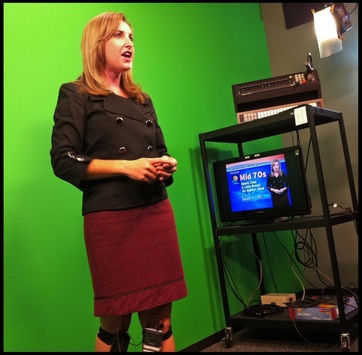After successfully passing the multiple choice exam, applicants will receive instructions on submitting two working weathercasts for review by the AMS Board of Broadcast Meteorology with one of the submissions coming from a day on which the weather would be considered “active”; the other from a day on which the weather would be considered “routine” for the broadcast market.
No minimum time of each segment is required. However, there is a maximum time limit of 5 minutes per segment. Submitted segments must be complete, as broadcast, in their entirety. For example, submitting the first half of a 5pm show and ending with part of a 10pm show, for one of the two (2) days is not permitted. Those whose weathercasts are short in time, but frequent in number (morning shows, cable news, etc.), may wish to include several consecutive segments, that approximate a single "full weathercast" when combined, for each day. Anyone exercising this option must clearly state such.
Weathercasts may be submitted in Spanish and will be evaluated by the AMS standing Board of Spanish-language evaluators. An English-language transcript of the broadcasts is required, but closed captioning is not. Please indicate on your application if you would like to submit Spanish-language weathercasts.
Off-air weathercasts will not be accepted, with the exception of those from applicants not currently employed or not employed as an on-air meteorologist at a local television station. In this case, to better simulate the “on-air experience,” a single take with no post-production is required, and it must be recorded with current rather than archived data. The forecast and required climatology sheet should focus on one specific location.
Past AMS Broadcast Board Chairs Carrie Rose and Rob Eicher offer tips and advice on the CBM weathercast evaluation.
Active Day
The definition of "active" may vary from one market to another; for instance, an "active" day in the central United States could mean thunderstorms, while an "active" day on the Pacific coast could be rain and fog, and an "active" day in the Great Lakes could mean lake effect snow. Some other examples of an active day could be involving tropical weather, a commute impacted by snow/ice, wildfire coverage, high winds, heavy rain and flash flooding, dense fog, or poor air quality. Your active day should showcase your best work on a day when a weather event will impact your viewers and may have the potential to be a threat to life and property. An active day may also be when weather is the top story in the newscast.
Routine Day
A “routine” day should showcase your best work on a quiet, typical weather day. The submissions do not need to be from consecutive days; however, they must be from the time period of two months prior to the request to submit air checks, to two months after the notice.
Submitted weathercasts should be of your best work and should follow the guidelines outlined above. If submissions do not meet these guidelines, your grade will reflect any deficiencies.
Example of a Weathercast Submission Graded Favorably
The below links are examples of a weathercast submission that has met the requirements and was graded favorably by the Board of Broadcast Meteorologists. Also included are comments from the reviewers. These have been provided so that you will have a better idea of what to include in your submissions.
Active weathercast example Routine weathercast example Reviewer comments

Review Criteria
The Board will review the submissions based on three criteria:
a) Graphical Content - This category will be used to evaluate the visual presentation and clarity in creating the proper storyline to the local weather.
b) Explanation - Reviewers are asked to determine whether or not the candidate has given scientifically valid explanation of the processes that produce the recent, current, and anticipated weather conditions
c) Presentation - This criterion is intended to measure the candidate’s ability to communicate the weather story to their audience.
A candidate must score above a 3.0 average in each category in order to succeed on the evaluation.
Supporting Documents
Board Statement on Weathercast Submission Requirements
Tips from the Board of Broadcast Meteorology for Earning a CBM